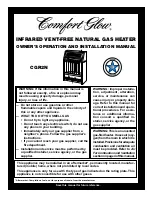
LP-436 Rev. 5.20.15
8
Locate the water heater where any leakage from the relief valve,
related piping, tank, or connections will not result in damage
to surrounding areas or lower floors of the building. The water
heater should be located near a floor drain or installed in a drain
pan. Leakage damages ARE NOT covered by warranty.
Failure of the water heater or components due to incorrect
operating conditions IS NOT covered by product warranty.
Figure 2 - Minimum Service Clearances
NOTE:
If you do not provide the minimum clearances shown in
Figure 2 it might not be possible to service the heater without
removing it from the space.
B. Minimum Clearances
The minimum clearances from combustible materials for this
water heater are: 6” (15.2 cm) from the sides and rear, 24” (61
cm) from the front, and 18” (45.7 cm) from the top.
C. Combustion and Ventilation Air Supply
In order for the water heater to operate properly, it must be
supplied with an uninterrupted flow of clean combustion and
ventilation air. The area around the water heater must always
be kept clear so that the flow of combustion and ventilation air
is not blocked. An inadequate supply of air to the water heater
will produce a bright yellow burner flame, causing sooting in
the combustion chamber, on the burners, and in the flue tubes.
This can result in damage to the water heater and serious bodily
injury if not corrected.
Combustion and ventilation air requirements are determined by
the water heater location. Water heaters are installed in either
open (unconfined) spaces or smaller (confined) spaces, such as
closets or small rooms.
1. Requirements for Unconfined Spaces
An unconfined space is an area with at least 50 cubic feet for each
1,000 BTU/H of the total input rating for all gas-fired appliances
installed in that space. Water heaters installed in unconfined
spaces do not usually require outdoor air to function properly.
However, in buildings with tight construction (heavy insulation,
vapor barriers, weather stripping, etc.), and particularly in
modern buildings, additional fresh air may need to be provided.
For instructions on obtaining additional air supply, see the
requirements for confined spaces.
2. Requirements for Confined Spaces
In the US (refer to ANSI Z223.1/NFPA 54)
a. All Air From Inside the Building
The confined space shall be provided with two permanent
openings communicating directly with one or more rooms of
sufficient volume, so that the combined volume of all spaces
meets the criteria for an unconfined space. The total input
rating of all gas appliances installed in the combined space
shall be considered in making this determination.
Each opening shall have a minimum free area of one (1) square
inch per 1,000 BTU/H (22cm
2
/kW) of the total input rating of
all gas appliances in the confined space, but not less than one
hundred (100) square inches (645.16 cm
2
). One opening shall
commence within six (6) inches (15.2 cm) of the top and one
within six (6) inches (15.2 cm) of the bottom of the enclosure.
Figure 3 -
Confined Space - All Air from Inside Building
b. All Air From Outdoors
The confined space shall be provided with two permanent
openings, one commencing within six (6) inches (15.2 cm)
of the top and one commencing within six (6) inches (15.2
cm) from the bottom of the enclosure. The openings shall
communicate directly or by ducts with the outdoors or spaces
(crawl or attic) that freely communicate with the outdoors.
1)
When communicating directly with the outdoors, each
opening shall have a minimum free area of one (1) square inch
per 4,000 BTU/H (5.5 cm
2
/kW) of the total input rating of all
gas appliances in the enclosure. See Figure 4.
When drawing combustion air from the outside into the
mechanical room, care must be taken to provide adequate
freeze protection.
Failure to provide an adequate supply of fresh combustion
air can cause poisonous flue gases to enter the living space,
resulting in severe personal injury or death.
A confined space is an area where the volume is less than
50 cubic feet for each 1,000 BTU/H of the total input rating
for all gas appliances installed in that space. Water heaters
installed in confined spaces require additional combustion
and ventilation air. This can be provided in two ways:
Summary of Contents for CG N65 Series
Page 17: ...LP 436 Rev 5 20 15 17 Figure 17 Wiring the Control...
Page 24: ...LP 436 Rev 5 20 15 24...
Page 25: ...LP 436 Rev 5 20 15 25...
Page 26: ...LP 436 Rev 5 20 15 26...
Page 27: ...LP 436 Rev 5 20 15 27...
Page 28: ...LP 436 Rev 5 20 15 28...









































